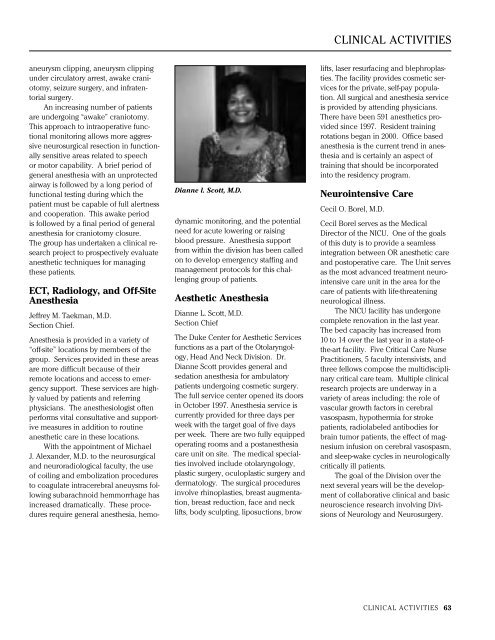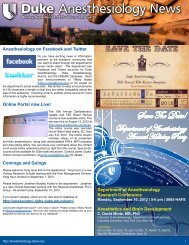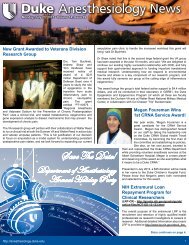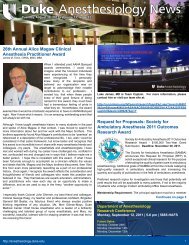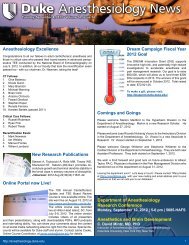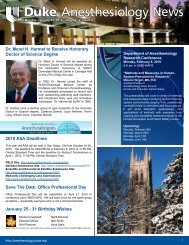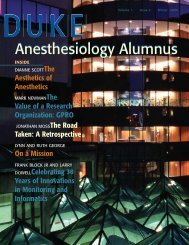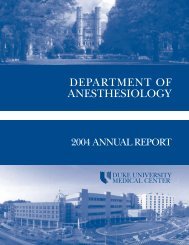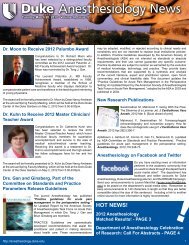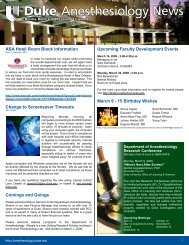DEPARTMENT OF ANESTHESIOLOGY ANNUAL REPORT
DEPARTMENT OF ANESTHESIOLOGY ANNUAL REPORT
DEPARTMENT OF ANESTHESIOLOGY ANNUAL REPORT
Create successful ePaper yourself
Turn your PDF publications into a flip-book with our unique Google optimized e-Paper software.
aneurysm clipping, aneurysm clipping<br />
under circulatory arrest, awake craniotomy,<br />
seizure surgery, and infratentorial<br />
surgery.<br />
An increasing number of patients<br />
are undergoing “awake” craniotomy.<br />
This approach to intraoperative functional<br />
monitoring allows more aggressive<br />
neurosurgical resection in functionally<br />
sensitive areas related to speech<br />
or motor capability. A brief period of<br />
general anesthesia with an unprotected<br />
airway is followed by a long period of<br />
functional testing during which the<br />
patient must be capable of full alertness<br />
and cooperation. This awake period<br />
is followed by a final period of general<br />
anesthesia for craniotomy closure.<br />
The group has undertaken a clinical research<br />
project to prospectively evaluate<br />
anesthetic techniques for managing<br />
these patients.<br />
ECT, Radiology, and Off-Site<br />
Anesthesia<br />
Jeffrey M. Taekman, M.D.<br />
Section Chief.<br />
Anesthesia is provided in a variety of<br />
“off-site” locations by members of the<br />
group. Services provided in these areas<br />
are more difficult because of their<br />
remote locations and access to emergency<br />
support. These services are highly<br />
valued by patients and referring<br />
physicians. The anesthesiologist often<br />
performs vital consultative and supportive<br />
measures in addition to routine<br />
anesthetic care in these locations.<br />
With the appointment of Michael<br />
J. Alexander, M.D. to the neurosurgical<br />
and neuroradiological faculty, the use<br />
of coiling and embolization procedures<br />
to coagulate intracerebral aneuysms following<br />
subarachnoid hemmorrhage has<br />
increased dramatically. These procedures<br />
require general anesthesia, hemo-<br />
Dianne l. Scott, M.D.<br />
dynamic monitoring, and the potential<br />
need for acute lowering or raising<br />
blood pressure. Anesthesia support<br />
from within the division has been called<br />
on to develop emergency staffing and<br />
management protocols for this challenging<br />
group of patients.<br />
Aesthetic Anesthesia<br />
Dianne L. Scott, M.D.<br />
Section Chief<br />
The Duke Center for Aesthetic Services<br />
functions as a part of the Otolaryngology,<br />
Head And Neck Division. Dr.<br />
Dianne Scott provides general and<br />
sedation anesthesia for ambulatory<br />
patients undergoing cosmetic surgery.<br />
The full service center opened its doors<br />
in October 1997. Anesthesia service is<br />
currently provided for three days per<br />
week with the target goal of five days<br />
per week. There are two fully equipped<br />
operating rooms and a postanesthesia<br />
care unit on site. The medical specialties<br />
involved include otolaryngology,<br />
plastic surgery, oculoplastic surgery and<br />
dermatology. The surgical procedures<br />
involve rhinoplasties, breast augmentation,<br />
breast reduction, face and neck<br />
lifts, body sculpting, liposuctions, brow<br />
CLINICAL ACTIVITIES<br />
lifts, laser resurfacing and blephroplasties.<br />
The facility provides cosmetic services<br />
for the private, self-pay population.<br />
All surgical and anesthesia service<br />
is provided by attending physicians.<br />
There have been 591 anesthetics provided<br />
since 1997. Resident training<br />
rotations began in 2000. Office based<br />
anesthesia is the current trend in anesthesia<br />
and is certainly an aspect of<br />
training that should be incorporated<br />
into the residency program.<br />
Neurointensive Care<br />
Cecil O. Borel, M.D.<br />
Cecil Borel serves as the Medical<br />
Director of the NICU. One of the goals<br />
of this duty is to provide a seamless<br />
integration between OR anesthetic care<br />
and postoperative care. The Unit serves<br />
as the most advanced treatment neurointensive<br />
care unit in the area for the<br />
care of patients with life-threatening<br />
neurological illness.<br />
The NICU facility has undergone<br />
complete renovation in the last year.<br />
The bed capacity has increased from<br />
10 to 14 over the last year in a state-ofthe-art<br />
facility. Five Critical Care Nurse<br />
Practitioners, 5 faculty intensivists, and<br />
three fellows compose the multidisciplinary<br />
critical care team. Multiple clinical<br />
research projects are underway in a<br />
variety of areas including: the role of<br />
vascular growth factors in cerebral<br />
vasospasm, hypothermia for stroke<br />
patients, radiolabeled antibodies for<br />
brain tumor patients, the effect of magnesium<br />
infusion on cerebral vasospasm,<br />
and sleep-wake cycles in neurologically<br />
critically ill patients.<br />
The goal of the Division over the<br />
next several years will be the development<br />
of collaborative clinical and basic<br />
neuroscience research involving Divisions<br />
of Neurology and Neurosurgery.<br />
CLINICAL ACTIVITIES 63


